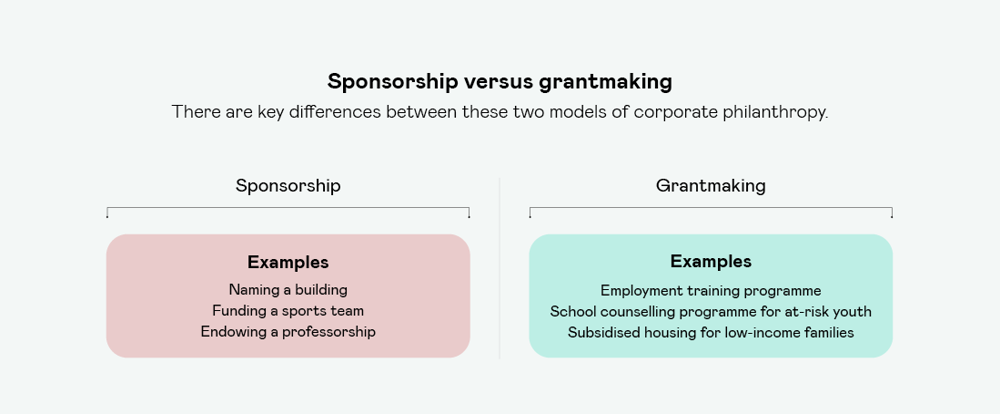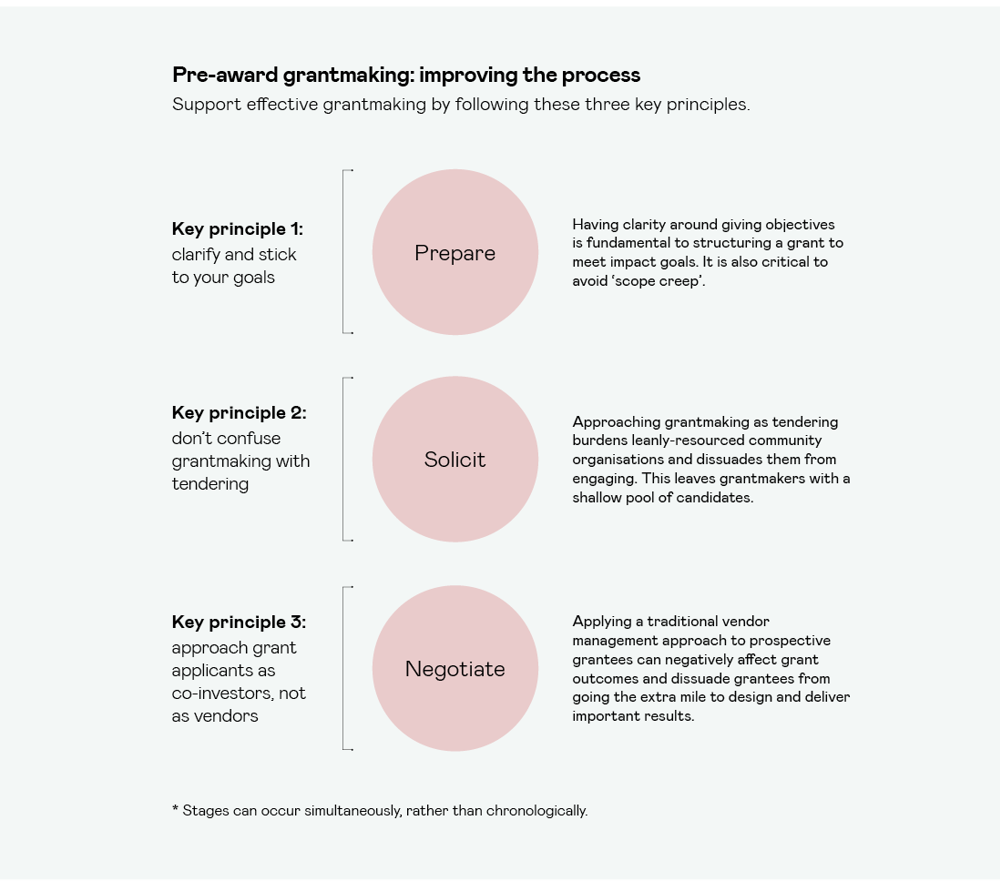Effective grantmaking:
part one
The first in a two-part series on best practices to improve the process for corporate philanthropy, this guide focuses on the pre-award stage

The first in a two-part series on best practices to improve the process for corporate philanthropy, this guide focuses on the pre-award stage

This guide introduces three key principles for effective grantmaking and outlines best practices to improve the process for corporate philanthropy.
Corporate giving among Fortune 500 firms exceeds $20bn a year. While these budgets for ‘doing good’ seem large, they are dwarfed by the size of global development needs. The United Nations estimates that to achieve the Sustainable Development Goals (SDGs) by 2030, it will require additional annual spending of up to $7trn. While much of that will come from governments in developed nations, a significant shortfall remains.
The private sector and corporate philanthropy can play a important role in plugging the development funding gap. In order to stretch budgets further, corporate givers must also ensure that the ways in which funds are deployed maximises impact.
Corporate philanthropy is typically carried out through two vehicles: sponsorship and grantmaking. Sponsorship is commonly a donation of cash, in-kind goods, or services and is a quick method of deploying resources. Grantmaking, however, is a more involved vehicle employed when an organisation wants to exercise influence over where, how, and for whom its resources are used.
The key defining characteristic of sponsorship is that it is generally ‘no strings attached’ and the recipient can use the resources with a high degree of freedom. Grants, on the other hand, are usually governed by a budget, scope of work, or other parameters.
Both vehicles can support impactful giving but as sponsorships are less complicated, this guide will focus on the key elements needed to support effective grantmaking.

Upholding the following three key principles can improve each stage of the basic pre-award grantmaking process:

Why this is important. Having clarity around your giving objectives is key to structuring your grant to meet impact goals. It is also critical to avoid scope creep. This is the frequent adjustment of the deliverables covered by a grant, often due to lack of clarity and focus around objectives. Another common trigger is the desire among applicants to please the grantmaker by bending to every request during the application process.
Scope creep is disruptive in the pre-award phase because it creates a ‘moving target’ that can be difficult for applicants to meet. It causes a distraction, reducing the likelihood that proposals will be delivered on time, in budget, or at all. While it is noble to augment your scope, doing so as part of an existing grant process can detract from your original goals and even jeopardise the quality of your programme.
Best practice. It is perfectly acceptable - and even encouraged - to re-evaluate and alter your giving objectives over time. It is not recommended to make these changes during open grant negotiations. It also may be tempting to work with an existing applicant pool to service your evolving needs, but that group may not always be best placed to do so. If your scope does evolve beyond the core capabilities of your pool, encouraging applicants to partner with other well-suited organisations can be a good way to ensure proposals remain robust.
Your corporate philanthropy is focused on alleviating overcrowding in urban areas. You prepare a grant process to offer subsidised housing to low-income families in one part of the city, but while evaluating proposals you learn that many of the young members of those households are also struggling in school. In response, you ask your grant applicants to resubmit their proposals to also offer tutoring programmes to supplement student learning. None of the applicants have expertise in this area, but in an effort to win your funding, they agree to the expanded scope, despite the risks to quality.
Why this is important. Approaching grantmaking as you would a contract tender risks unduly burdening leanly-resourced community organisations, many of which may be unable to meet the demands of the application process. This can dissuade them from applying, leaving grantmakers with a shallow pool of candidates to choose from.
Best practice. Reduce or eliminate hurdles in the application process to encourage engagement from a wide pool of organisations. Request only the content and documents that are needed to evaluate the proposal, or consider subsidising the proposal process if the requirements are particularly onerous.
Your corporate philanthropy wants to make a grant to encourage healthy eating habits in a particular community. Several community organisations are involved in this kind of work and you are confident they will be interested in applying. Your procurement department manages the grant process. As the deadline arrives, only a handful of responses are received, most of which are from well-funded international organisations that submit generic marketing materials instead of tailored proposals. As you reach out for feedback from the organisations that did not respond, you learn that many felt your application favoured large NGOs. Your procurement department requested many documents, of questionable relevance, that were too time-consuming for these applicants to organise. You learn that the instructions indicated that only printed, colour, couriered proposals would be accepted, and that most organisations could not bear the cost for expedited international shipping from their rural office. Several organisations reported having submitted questions that went unanswered. The procurement department as a policy did not respond to during the initial rounds of tendering, leaving organisations without enough information to present well-crafted applications.
Why this is important. You may be tempted to employ vendor-related policies to govern a grantor-grantee contract, and there is no doubt that a grant is a contract by which both parties will be bound. However, applying the same approach designed to extract maximum financial value from grantees will likely negatively affect your outcomes and dissuade grantees from going the extra mile to deliver important results.
Best practice. Achieving your goals requires a strong relationship with the delivery organisation that will ultimately drive impact. Approaching the grantee relationship as a partnership will better position your joint endeavour for success. Partnering for success means structuring your relationship in a way that does not distract from delivering results and instead nurtures growth. Here are some ways you can support your grantees:
Your corporate philanthropy commits to improving the maths and science attainment for students in local schools. You measured the baseline of test scores and set a goal for 10 percent improvement across all students in this academic year. You draft a call for grant applications and specify that the award is for a single year and must only be spent on new textbooks and teaching aids. After you award your grant, you are shocked to find that eight months have passed, and test scores have not improved. You call a meeting with your grantee, who is aware of the problem, but admits that staff are busy preparing the extensive application needed to secure a second year of funding. They have very little time to dedicate to the existing operations, or to ensure they are meeting programme goals.
1. Eliminate hurdles. Minimise or remove barriers in the application process to encourage engagement from small or lean organisations.
2. Create a level playing field. This allows responders to efficiently focus efforts and encourages applications from lean organisations that cannot develop professionally designed or broad proposals, but that excel in delivering strong content.
3. Rethink the funding model. Flexible funding models are often better aligned with the demands of implementing a programme. Allow room for adjustment and innovation and consider the following:
It's a good idea to use a strong password that you're not using elsewhere.
Remember password? Login here
Our content is free but you need to subscribe to unlock full access to our site.
Already subscribed? Login here